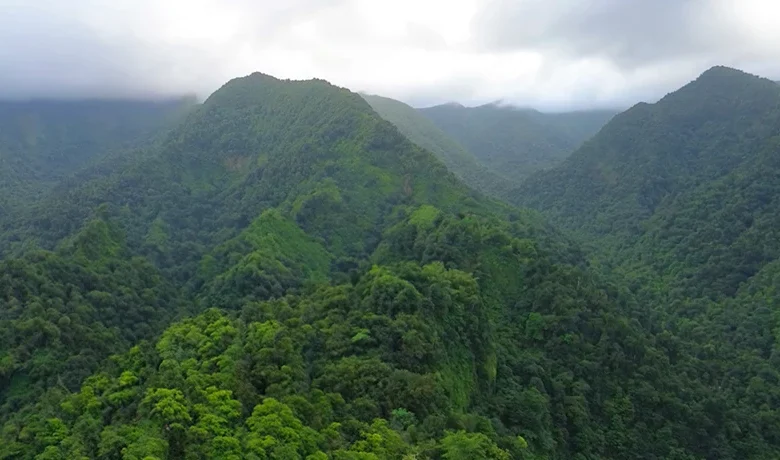Mountainous Rainforests of Dominica

Dominica’s mountainous rainforests are among the most ecologically diverse regions in the Caribbean, earning the island the title of “Nature Island of the Caribbean”. These rainforests are essential to the island’s Cultural Heritage and natural landscape. Dominica’s volcanic origins have shaped its rugged landscape, including towering mountains like Morne Diablotin (Dominica’s highest peak) and Morne Trois Pitons, surrounded by dense tropical rainforests. These forests play a critical role in the island’s ecosystem, protecting soil from erosion, regulating water flow, and serving as habitats for the island’s rich biodiversity.
Rainforest Zones and Unique Features
Dominica’s mountainous rainforests are divided into different ecological zones based on elevation, each with unique species and characteristics:
- Lowland Tropical Rainforest: Dominated by towering hardwood trees, this zone has many flora and fauna, including ferns, orchids, and native palms.
- Montane forests: At higher elevations, the montane rainforest is cooler and mistier, providing a habitat for rare species such as the Sisserou Parrot and the Jaco Parrot, Dominica’s Endemic Birds.
- Elfin Woodland: At the highest elevations, the elfin woodland is characterized by shorter, wind-sculpted trees and is often blanketed in mist. This zone plays a crucial role in water regulation by trapping moisture from the clouds, feeding the island’s many rivers and waterfalls.
Dominica’s Morne Trois Pitons National Park, a UNESCO World Heritage Site, showcases the island’s rainforests in their full glory. It features geothermal features like the Boiling Lake and several of the island’s stunning waterfalls, such as Trafalgar Falls and Middleham Falls.
Biodiversity and Endangered Species
Dominica’s mountainous rainforests are critical for preserving biodiversity. They are home to many endemic species, including the critically endangered Sisserou Parrot (Amazona imperialis), Dominica’s National Bird. Other species include the Jaco Parrot (Amazona arausiaca) and various reptiles, amphibians, and insects unique to the island. The Forestry, Wildlife, and Parks Division is the primary government unit responsible for protecting these species and their habitats. Conservation efforts focus on sustainable land use, reforestation projects, and preserving natural habitats.
Role of Government and Organizations
The Ministry of Environment, Rural Modernization, and Kalinago Upliftment oversees the protection of Dominica’s mountainous rainforests and promotes sustainable development in these regions. The Forestry, Wildlife, and Parks Division, part of the Ministry of Agriculture, works closely with local communities, NGOs, and international organizations to implement conservation strategies. Critical conservation efforts include:
- Protected Areas and National Parks: Dominica has designated vast areas of its rainforest as protected zones, including the Northern Forest Reserve and Morne Diablotin National Park.
- Waitukubuli National Trail: This trail, the longest hiking trail in the Caribbean, crosses Dominica’s rugged terrain and passes through multiple rainforest ecosystems, promoting eco-tourism while ensuring minimal environmental impact.
The government’s Eco-Tourism Development Programme (ETDP) also significantly promotes Dominica’s rainforests as a sustainable tourism destination. This initiative, which involves partnerships with local communities, focuses on adventure tourism activities like hiking, birdwatching, and river tubing while ensuring that these activities do not harm the delicate ecosystem.
Importance of Sustainable Tourism and Conservation
Sustainable tourism is at the heart of Dominica’s efforts to preserve its mountainous rainforests. The island’s Eco-Tourism Development Programme (ETDP) balances tourism with environmental protection, encouraging visitors to experience the rainforests through eco-friendly activities. Government bodies like the Ministry of Tourism and local organizations work together to promote awareness about protecting the island’s natural resources. Conservation measures, such as reforestation and anti-deforestation campaigns, are regularly enforced to preserve Dominica’s natural beauty for future generations.




